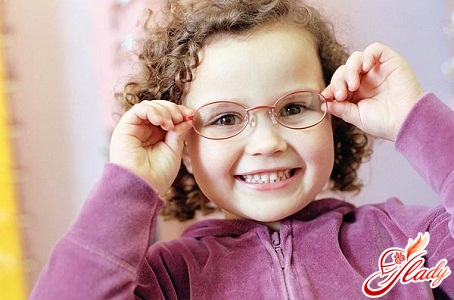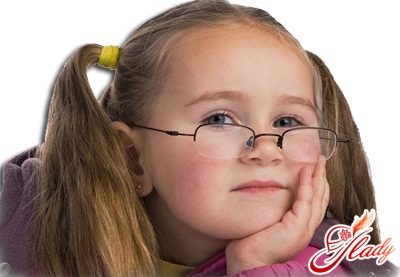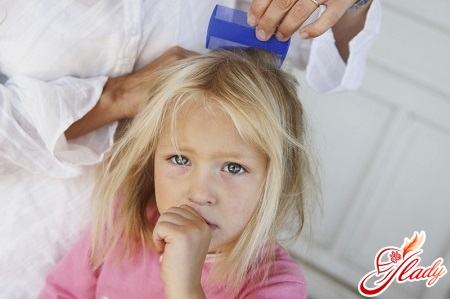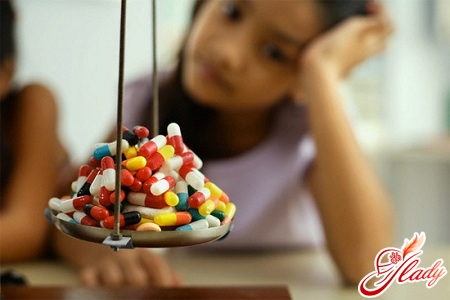 Recently, more and more often doctors -Ophthalmologists have to diagnose various visual impairments. Very often, doctors diagnose strabismus in children under one year. This is influenced by a huge number of different factors, including the environmental situation, computers and televisions, firmly embedded in the life of modern man, complications during pregnancy with my mother and many others. An important factor is the genetic predisposition factor - vision problems often have the property to be passed on from generation to generation, from children to parents. In the event that the kid's parents have any vision problems, whether they are nearsightedness, hyperopia, astigmatism or strabismus, there is a serious risk that their child will have a tendency to the same diseases. That's why parents who have vision problems should treat their baby's eyes as carefully as possible. After the baby reaches the age of three months, the parents must go to the ophthalmologist to get the first consultation in life. Most often the direction to the doctor - an ophthalmologist is given by that doctor - a pediatrician who observes the baby. However, if you are for any reason the pediatrician did not give a referral to the oculist, do not hesitate and remind him yourself about it. An ophthalmologist will carefully examine your baby and carry out the necessary examination, which will help the doctor to identify possible visual impairments. In the event that the crumb has any problems, the doctor will tell the parents about what needs to be done next. And in the event that the child needs treatment, it is the doctor - ophthalmologist who will decide the scheme of treatment, or he will send for hospitalization in a specialized hospital. If your family has no vision problems, the baby's first visit to the oculist should be in six months. After that, if the doctor - an ophthalmologist does not reveal any violations, the next visits will take place according to plan, during the child's preventive examinations. In no case, if the doctor said that the eyesight of the child is OK, do not ignore subsequent visits. As is known, not all vision problems are congenital - many eye diseases are acquired with time, under the influence of a huge number of adverse effects on the baby's eyes. Similarly, parents should be reminded that in no case should they rely solely on doctors. Firstly, you will not visit an ophthalmologist every week, will you? And secondly, individual symptoms of certain diseases can be noticed only by parents who spend with their child almost all the time. Therefore, moms and dads should be extremely careful and watch the crumbs. Doctors - ophthalmologists, as a rule, tell their parents about which aspects of the child's vision should be paid special attention. Below we described the main ones - carefully read and try to remember this information. So:
Recently, more and more often doctors -Ophthalmologists have to diagnose various visual impairments. Very often, doctors diagnose strabismus in children under one year. This is influenced by a huge number of different factors, including the environmental situation, computers and televisions, firmly embedded in the life of modern man, complications during pregnancy with my mother and many others. An important factor is the genetic predisposition factor - vision problems often have the property to be passed on from generation to generation, from children to parents. In the event that the kid's parents have any vision problems, whether they are nearsightedness, hyperopia, astigmatism or strabismus, there is a serious risk that their child will have a tendency to the same diseases. That's why parents who have vision problems should treat their baby's eyes as carefully as possible. After the baby reaches the age of three months, the parents must go to the ophthalmologist to get the first consultation in life. Most often the direction to the doctor - an ophthalmologist is given by that doctor - a pediatrician who observes the baby. However, if you are for any reason the pediatrician did not give a referral to the oculist, do not hesitate and remind him yourself about it. An ophthalmologist will carefully examine your baby and carry out the necessary examination, which will help the doctor to identify possible visual impairments. In the event that the crumb has any problems, the doctor will tell the parents about what needs to be done next. And in the event that the child needs treatment, it is the doctor - ophthalmologist who will decide the scheme of treatment, or he will send for hospitalization in a specialized hospital. If your family has no vision problems, the baby's first visit to the oculist should be in six months. After that, if the doctor - an ophthalmologist does not reveal any violations, the next visits will take place according to plan, during the child's preventive examinations. In no case, if the doctor said that the eyesight of the child is OK, do not ignore subsequent visits. As is known, not all vision problems are congenital - many eye diseases are acquired with time, under the influence of a huge number of adverse effects on the baby's eyes. Similarly, parents should be reminded that in no case should they rely solely on doctors. Firstly, you will not visit an ophthalmologist every week, will you? And secondly, individual symptoms of certain diseases can be noticed only by parents who spend with their child almost all the time. Therefore, moms and dads should be extremely careful and watch the crumbs. Doctors - ophthalmologists, as a rule, tell their parents about which aspects of the child's vision should be paid special attention. Below we described the main ones - carefully read and try to remember this information. So:
- The reaction of the baby is not light
Almost all young mothers have watched more than oncethe next picture: the child's room turns on the light, and the child immediately reacts to this - turns the head, closes the eyes and shows other signs of discontent. It is this reaction that is the physiological norm. Blinking, the child thus instinctively protects his eyes, helping them to adapt to bright lighting. But in the event that the baby does not react in any way to bright lighting, especially to the light included in the dark room all at once, parents need to be alerted. In this case, two possible explanations are possible: either you are lucky and you are the parents of an unrealistically quiet child or, what is more likely, your crumb has some problems with vision. To find out if this is so, try to accidentally direct a beam of light directly into the baby's eyes and hold it for 1 to 2 seconds. Do not let the baby "solar rabbits" in the eye - this can damage the retina of the eye. If, in this case, the baby does not react in any way to bright light, parents should as soon as possible seek help from an ophthalmologist and show him the child. The doctor examines the child and will accurately diagnose or, on the contrary, dispel your fears and fears.
- Recognizing your toys
Please note, can your babyindependently find their toys by sight - rattles, balls, dolls. In the event that the sight of the child is all right, he even at a distance will recognize his toys. And the child should equally well see them both eyes - both right and left. If your child is big enough, you can try to check your eyesight yourself - show him an item, asking him to name it. After that, go to the finer details - for example, ask to say what color the wheel is at the typewriter or find out if there is a pocket on the doll's skirt. But even if the baby is not big enough and can not keep up the dialogue for the time being, attentive parents are able to notice that the eyesight is not all right. So, for example, some parents, whose children suffer from eye diseases, say that very often there is such a situation when the child stubbornly pulls his hands to the person interested in his subject. But as soon as you give him the object, the kid throws it and can even burst into tears. This is because the crumb is disappointed, since the object was not what the kid wanted to get. If this happens periodically with your baby, be sure to consult a doctor - an ophthalmologist.
- Narrowing the peephole
You noticed that sometimes, looking at someobjects that are at a great distance from the child, your baby begins to screw up his eyes? Try to ask him some guiding questions that will allow you to understand whether the child sees these items. If the child can not answer these questions, or if he complains that he does not see well, take this into consideration and show the child to the ophthalmologist as soon as possible.
- Evaluation of the location of various objects
A very important factor in good vision isthe child's ability to follow the moving subject without losing sight of it. Even quite small crumbs discover this skill, watching the eyes of the mother, a rattle or a mobile. If your baby can not do it, show it to the doctors. And notice that you need advice not only from the ophthalmologist, but also from the neurologist, since the child's inability to follow the objects can also indicate the presence of disturbances in the normal functioning of the central nervous system.
- Redness of the eye, lacrimation
If the eyes of the child periodically lookinflamed and red, pay attention - do not overload the child's eyes - maybe he spends too much time in front of the TV or a computer? Could it be that he recently cried? If the eyes turn red from time to time, and for no apparent reason, this is also a warning signal for the parents - be sure to consult a doctor - ophthalmologist, who will help establish the cause of regular inflammation of the eyes. 
Strabismus in children
Another common diseaseThe visual apparatus in the child is a squint. However, in itself, strabismus is rarely an independent violation. Most often, strabismus is a concomitant phenomenon of such diseases as astigmatism and hyperopia. And in especially severe cases of flow divergent strabismus in children is a consequence of myopia. Parents should remember that child's squint is not just a kind of cosmetic defect, but a severe disruption of the entire visual apparatus. Normally, the human visual system has a structure in which two different pictures from two eyes come through the visual channels to certain parts of the brain, where they are reunited into a single whole. And only with the correct, well-coordinated work of the entire visual apparatus, the picture acquires the correct clear outlines, thanks to which the person sees objects in the right perspective, and also can adequately orient themselves in space. A crumb that has just come to our world, is in principle unable to look and see clear objects. The ability to see both eyes (binocular vision) develops in the child gradually, finally forming only to 4 - 5 years. I would like to recall that at this age, all babies are also subject to physiological myopia, which is directly related to the development of strabismus. Therefore, treatment should be exceptionally complex - only in this case it is possible to achieve positive dynamics. Most often, strabismus is diagnosed in children between the ages of three and five, but strabismus in infants is quite common. As a rule, the symptoms of trouble are first noticed by parents of children who spend all their free time with their children. Many parents ask how to determine the child's strabismus. In fact, if the child's strabismus does appear, you will immediately notice it with the naked eye, even without special education. And if you notice that your child is slightly mowing, hurry as soon as possible to seek help from a pediatrician - an ophthalmologist for advice. Do not be afraid that you will disturb the doctor in vain - if it is about the health of the child, it is much better to be safe than to miss the onset of a disease. No doctor will refuse you help, and will not blame you. After all, only an ophthalmologist knows how to treat strabismus in children. Correction of strabismus in children is a laborious process and requires a lot of effort, both from the physician and from the parents.
Treatment of strabismus
Treatment of strabismus in children should becomplex and timely begun. First, it is very important to begin treatment of the underlying disease - myopia, hyperopia or astigmatism. It is very important to choose the correct glasses for the child - this should also be done by the ophthalmologist, but not by the opticians. Often correctly selected glasses can greatly reduce the degree of strabismus, reducing it to almost zero. However, such treatment is often not enough. In this case, ophthalmologists provide the children with complex hardware treatment. The program of treatment for each child is selected exclusively individually, taking into account the features of the vision of each child. In some cases, if the doctor deems it necessary and sees the presence of strong evidence for this, he will place the child in the ophthalmology department of the hospital for subsequent surgical intervention. The purpose of this operation is correction of the eye muscles, resulting in almost complete cure for strabismus. After, with the help of surgical intervention, doctors will restore the normal correct movement of the eyeball, the child will receive complex conservative treatment within a certain time. With this treatment, doctors achieve almost complete rehabilitation of the visual function in the child. Also, with the help of certain methods of practicing doctors fully restore the ability of the baby to stereoscopic vision. And once again I would like to recall that the strabismus in children causes a variety of reasons - so it is very important to establish the true. Below, we outlined the most common of them, but remember that in no case can you try to diagnose yourself - this can lead to the most unpredictable consequences. The information in this article is given only for general introduction of parents into the course of the case and can not be used as a guide to independent treatment.
Myopia in children
One of the most common violationsvision in children is myopia. Most often, this disease is directly related to the presence of human TVs, computers and interactive learning technologies. Most often, it is during the development of the visual system of the baby that it is overloaded. And, as a result, in the eyes of the child there are pathological disorders. Which, in turn, leads to the development of myopia. Very many parents underestimate the real danger of uncontrolled sitting at the computer and watching the TV crumbs. In order to understand this, it is just necessary to clearly imagine what exactly is happening with the vision of the child when watching TV. When the kid looks at the monitor or TV screen, the image is projected directly onto the child's retina. According to natural physiology, all young children often have farsightedness. With farsightedness in order to see the object (in this case, the image), located at a distance, the child is forced to tighten his eyes. If the child spends too much time in front of the TV, there is a so-called lengthening of the eye and, as a consequence, the development of myopia. Slightly less common congenital myopia in children. Treatment for myopia should begin as soon as possible. And treatment, in order to achieve visible success, must necessarily be complex. Treatment of myopia in children in most cases is conservative and includes the following components:
- Classes with the child on special simulators, the action of which is aimed at strengthening the muscles of the visual apparatus. These sessions should be conducted under the strict supervision of an ophthalmologist.
- Pharmacological pharmacological preparations,strengthening the eyes of the baby. Remember that an incorrectly selected drug will only worsen the child's vision, so all drugs should be selected and prescribed by a doctor.
- Wearing glasses. Points are also selected strictly by the doctor, taking into account the individual characteristics of each particular baby. In the event that the nearsightedness of the child is not very pronounced - the glasses should be worn only in certain cases. If the disease progresses and takes severe forms, the constant wearing of glasses is simply mandatory. However, eyeglasses themselves do not cure the disease, but only correct vision, playing a passive auxiliary role.
In the same case, if the above methodsconservative treatment does not bring proper success and the child's vision continues to inexorably fall, the doctor may decide to perform a surgical intervention. This operation is called scleroplasty and aims to increase the nutrition of the eyeball. However, this operation, unfortunately, is also not a panacea and does not remove the subsequent need for conservative treatment of infantile myopia. As a rule, if the nearsightedness of children, treatment brings good results. 
Myths about myopia
Unfortunately, there is a hugethe number of myths and misconceptions concerning infantile myopia, especially as to how to treat myopia in children. Often they prevent parents from adequately assessing the situation and in time to seek medical help. In some cases, these myths add dark tones and pessimism to a look at this problem.
- Treatment of myopia with eye drops
Very often parents learn that their babysuffers from myopia, feverishly and with fanaticism begin to buy up all possible eye drops, mistakenly prigogaya that they will improve children's eyesight. In fact, this is not so - drops only bring temporary improvement, but do not treat the disease.
- Points for Life
Many parents are confident that once wearing glasses,the child will be forced to wear them all his life. However, this is not so - glasses do not heal and do not impair vision, but only correct it. And in the event that vision is not critically reduced, and the little one is able to do without glasses, do not force him to wear them. Especially cautious with glasses should be the parents of very young children - after all, whatever one may say, the lenses are made of glass. And the kids are very inquisitive and restless - there is always a risk that the crumb's glasses can be broken and wounded with glass. Therefore, if the nearsightedness of children under one year is two years, there can not be any glasses about them.
- Blueberries
It is widely believed that blueberries andpreparations containing the extract of blueberries are able to work miracles and at times improves the vision of the child. However, all preparations with blueberries are a double-edged sword. On the one hand, they are authorized for sale by the Ministry of Health, and on the other hand are not multivitamin complexes, but only food additives. Doctors, as a rule, are very skeptical about this drug, giving their preference to multivitamin complexes. Before buying any medication for a child, be sure to consult your physician - ophthalmologist.
Timely treatment and prevention of myopia
For some reason, there is an opinion among parents,that nearsightedness in young children is not necessary to treat, it will pass with time. This is one of the grossest mistakes that will not fail to affect the baby's vision for life. Physiological phenomenon in small children is hyperopia. But myopia needs to start treating as early as possible. If the disease is left without due attention, myopia will progress and may lead to irreversible pathological changes in the fundus. Just inappreciable role played by timely prevention of the development of myopia. Of course, first of all it concerns the children who do not have any problems with sight, but even those who have become sick, these measures are an integral part of the course of treating myopia. Their non-compliance worsens the course of the disease and reduces the effectiveness of treatment. Strictly dose the time and intensity of the load to the eyes. In any case, do not overload the visual system - this is very unfavorable for the child's vision. For example, watching TV - for children under two years of age it is not recommended to watch it at all, for children from two to four years old doctors are allowed to spend at the screen not more than twenty minutes a day, breaking this time into two views. Do not treat this caution with carelessness - it is not invented by doctors. In addition to the fact that a dynamic image on the screen loads the visual system of crumbs, it also irritates his nervous system. Often a child who spends a long time watching TV watching a cartoon, often naughty, sleeps badly at night. But parents simply do not connect this phenomenon with a long sitting at the TV.
Hyperopia in children
Hyperopia in young children occursquite often and in most cases is the physiological norm of the development of the visual system. Farsightedness in children up to a year is diagnosed in 7 children out of ten. The reason for hyperopia is that the eyeball is shorter than necessary. As a result, the refraction of the rays occurs behind the retina, and therefore the image is not clear at the bottom of the eyeball. By the way, all newborn babies without exception show physiological far-sightedness. If physiological far-sightedness is diagnosed in children, treatment is not necessary. However, as the crumbs grow, hyperopia disappears without any outside interference. This happens almost always. However, in rare cases, hyperopia does not disappear as the baby grows, but only intensifies. In especially severe cases, even the development of strabismus is possible. However, only a doctor - an ophthalmologist can decide on the treatment of hyperopia. However, the diagnosis can also be made only by a doctor and no one else. The causes of hyperopia in children can be very different. If the doctor believes that the child's long-sightedness is beyond the physiological norm, he can prescribe a certain treatment to the child. As a rule, these are various exercises to strengthen the eye muscles, hardware treatment, which in all cases is selected for each child individually. In addition, in particularly severe cases, during the treatment, the child may be shown wearing glasses that will remove excessive tension from the eye caused by the need for the child to strain his eyes to look at anything. Also, parents should not forget about preventive measures aimed at preventing the occurrence of hyperopia. For this, it is necessary to comply with all the measures mentioned above. They are valid not only for myopia, but also for hyperopia. It is also very important to regularly undergo preventive examinations with an ophthalmologist - children often do not realize that their vision has deteriorated and, accordingly, can not complain about it to their parents.
Children's astigmatism
Sometimes in infants there is such a violation aschildish astigmatism. Astigmatism is a consequence of the congenital disruption of the structure and development of the child's visual apparatus. With astigmatism in the eye of crumbs, there are simultaneously two optical focuses, instead of one put. And very often none of the two tricks is where it should be originally. It is from where the optical focuses are located, the degree of severity of the disease depends. It can be simple, complex or mixed astigmatism. An experienced ophthalmologist can easily determine the child's astigmatism and its degree. It is from the degree and type of the disease that the further tactics of the child's treatment will be determined. Modern treatment of child astigmatism is mostly conservative and aimed at training the necessary areas of the eyeball. In addition, the child, as a rule, a doctor - an ophthalmologist recommends wearing specially selected glasses for him. All the time that the treatment will continue, the child must be under constant medical supervision. As a rule, a child must undergo about three courses of treatment per year. To successfully achieve positive dynamics, it is necessary to begin treatment as soon as possible. The sooner the child begins to receive the necessary treatment, the more likely that the broken visual functions of the crumb will be restored in full. However, remember that, alas, completely to cure astigmatism is simply impossible, because it is an inborn violation of the structure of the visual apparatus. The only way to completely get rid of astigmatism is to perform laser vision correction. However, remember that this operation is not carried out for children under 10 years old. Therefore, if your baby is younger, the doctor will perform conservative treatment, which, if not improving, will at least prevent the disease from progressing until laser correction of vision is possible. Of course, problems with vision in children can not but frustrate and not scare all parents without exception. However, in no case should you despair, let alone give up. Modern medicine does not stand still, but is rapidly developing. And those eye diseases in children who had not previously been treated, but only corrected with the help of glasses, nowadays are successfully cured to the full. And most importantly it depends on the parents - timely treatment to the doctor. And your baby will delight you with his shiny and healthy eyes. We advise you to read:









